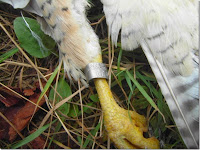It was thought that the peregrines at Bath had starting incubating a week earlier than usual, however this was hard to confirm as the female was sitting very tight. After what we thought was 40 days of incubation, the eggs had failed to hatch. Needless to say we were disappointed as we have been hoping for a full house of chicks as they had back in their first breeding attempt back in 2007 of 4 fledglings.
However it turned out we had got our laying date incorrect and one chick was seen on 2nd May. By the 8th we had four chicks! This was a very welcome surprise and we now have our fingers crossed that all four survive. The adult male 'AA' will have his work cut out to feed four hungry mouths this summer.
As with last year, the BBC are planning to film the ringing of the chicks towards the end of the month.
Thanks to Colin for his continued effort in monitoring the peregrines at Bath.




